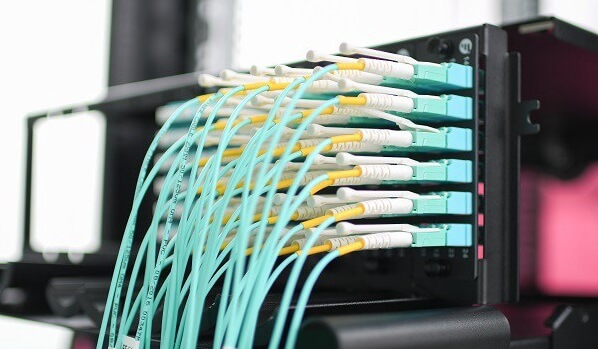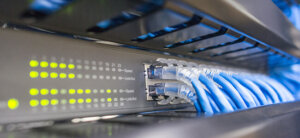Fiber optic jumper cables provide a highly reliable means of signal transmission and are widely used in the telecommunications industry. Selecting the right fiber optic jumper cables for a data center or network can be a challenging task because there are many kinds of products. Therefore, it is very useful to learn fiber jumper types.
1. What is fiber jumper?
Fiber jumper is a fiber optic cable with connectors such as LC, SC, etc. at both ends, and it is also called fiber optic patch cord. Fiber jumpers play an important role in indoor uses such as server rooms. Usually, they are used to connect fiber optic transmitters and fiber optic transceivers.
2. Understanding fiber jumper types
Optical fiber jumpers are divided into different types according to the optical cable mode, transmission mode and connector type, etc.
2.1 Fiber jumpers are divided according to fiber optic cable modes: single-mode and multi-mode fiber jumpers
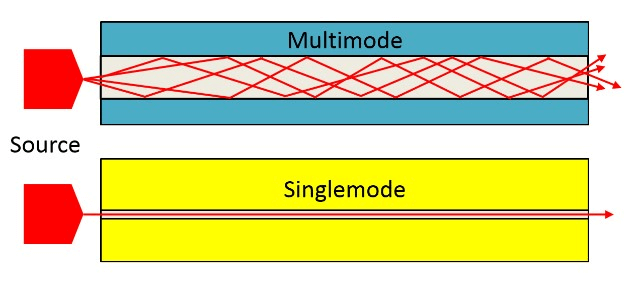
The mode of the fiber optic cable indicates how the light beam propagates within the fiber optic cable.
- Single-mode fiber jumpers allow only one mode of light to pass along its length, and have a very thin diameter of 8-10 μm, so it can transmit signals at higher speeds with lower attenuation, suitable for long-distance transmission. Single-mode fiber jumpers (OS1, OS2) are yellow, and the connector and protective cover are blue.
- Multimode fiber jumpers are more complicated. It is usually orange (OM1, OM2), light green (OM3, OM4), or green (OM5). Multimode fiber has a larger core, usually 50 or 62.5 μm, and can transmit a variety of light modes. The transmission distance of OM1 and OM2 at gigabit rate is 550m. Under the 10 Gigabit rate, the transmission distance of OM3 is 300m, and the transmission rate of OM4 is 400m. Connectors and protective sleeves are in beige or black. Multimode fiber patch cords are mainly used for transmission over short distances, such as buildings or campuses.
It is important to note that the two modes are not compatible and one cannot use one in place of the other.
Click here to learn more about the differences between single mode and multimode.
2.2 Fiber jumpers are divided according to transmission medium: silicon-based and plastic fiber jumpers
According to the different transmission media, fiber jumpers can be divided into common patch cords of silicon-based fiber, and other fiber optic jumpers such as those with plastic as the transmission medium. Silicon-based fiber has great heat protection, and plastic fibers have great flexibility and are lighter in weight.
2.3 Fiber jumpers are divided according to transmission modes: simplex and duplex fiber jumpers
A simplex fiber jumper has one fiber and one connector at each end. It is typically used when data transmission is required in only one direction. A duplex fiber jumper has two fibers and two connectors per end, where the signal in the duplex fiber needs to be transmitted in both directions, also known as bi-directional communication. Simplex fiber jumper can utilize the entire bandwidth of the communication channel, so more data can be transmitted at once. Duplex fiber jumper can send and receive data at the same time, which is very efficient.
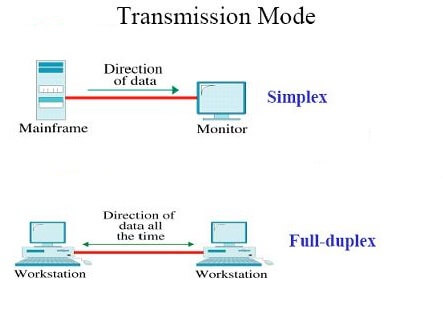
2.4 Fiber jumpers are divided according to the connectors: FC, ST, SC, LC, MU, LSH, E2000, MTRJ, and SMA fiber jumpers
Fiber jumpers can be classified by connectors as FC, ST, SC, LC, MU, LSH, E2000, MTRJ, SMA, etc. The following is a detailed description of some commonly used fiber optic patch cords.
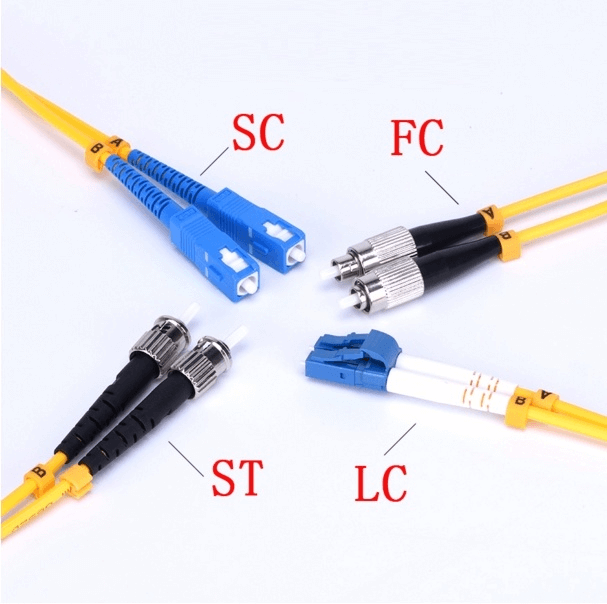
- FC fiber jumper: FC (Ferrule Connector) fiber patch cord belongs to one of the most common connection devices in single-mode networks. Its external reinforcement is a metal sleeve, fastened with a screw buckle. FC connectors are generally used in telecom networks, the advantage is that they are reliable and dust-proof, the disadvantage is that the installation time is slightly longer.
- SC fiber jumper: SC (Square Connector) fiber patch cord is a TIA-568-A standardized connector, it is not widely used at first because of the initial high price, but with excellent performance, it is gradually used in the connection with the GBIC optical module. It is commonly used in routers and switches. Its shell is rectangular, fastened by a plugging pin latch. Unlike ST/FC connectors, it does not need to rotate. Similar to LC connector, but SC connector is about twice its size.
- LC fiber jumper: LC (Lucent connector) fiber patch cord is a small square connector, and is currently the most popular connector. It is usually connected to SFP optical modules. The connector is similar to SC connector but smaller than SC connector, the size of the pin and sleeve is 1.25mm, which is half of the ordinary SC, FC, and it is fastened by the jack latch. LC connector has good performance. To a certain extent, it can improve the density of fiber optic connectors in the fiber optic patch panel, making it a good single-mode fiber patch cord.
- ST fiber jumper: ST (Stab & Twist) fiber patch cord is the most common connection device in multimode networks, and is also the more common connector type in Base10 fiber connections. ST connector is commonly used on fiber optic patch panels. Its shell is round, fastened by a screw, core exposed, needs to be inserted first, and then rotate 180° to fix the bayonet.
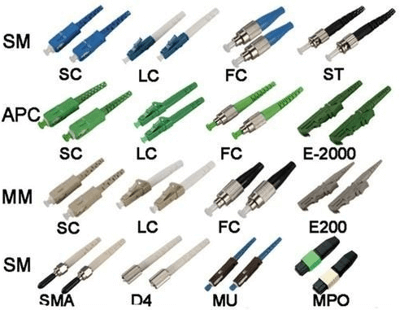
- MU fiber jumper: MU (Miniature Unit) fiber patch cords that look like SC connectors but with about half the size of ferrules.
- LSH fiber jumper: LSH fiber optic patch cord, lead connector with dust cover, can be automatically closed after the fiber is taken out.
- MTRJ fiber jumper: MTRJ fiber patch cords that take two fibers and integrate them into a design that looks similar to an RJ45 connector.
- E2000 fiber jumper: Both ends of the E2000 fiber patch cords are equipped with spring valves and push-pull locking devices. The pull-to-lock mechanism locks fully when you insert the connector, and the spring valve closes automatically when you pull it out. This connector features protection of the pins from contamination and wear.
- SMA fiber jumper: SMA fiber patch cord is small in size and used on special occasions in optical fiber communication systems, such as test equipment, data network, military equipment, medical equipment, etc.
Fiber jumpers can be terminated with the same connector type or a mix of connector types. The same connector type means that both ends of the fiber optic patch cord must be of one connector type. For the hybrid type, one end can be SC, the other end can be LC, FC, etc.
If the ports of both end devices are the same, you can use LC-LC/SC-SC fiber jumpers. If you want to connect different port-type devices, LC-SC/LC-ST/LC-FC fiber jumpers may be suitable for you.
users must also pay attention to different polishing types. There are three types of fiber optic connectors that can be used: PC, UPC and APC. Each polishing type represents a different level of back reflection. Since the loss of APC connectors is lower than that of UPC connectors, in general, the optical performance of APC connectors is better than that of UPC connectors. In the current market, APC connectors are widely used in more return loss sensitive applications such as FTTx, Passive Optical Networks (PON) and Wavelength Division Multiplexing (WDM). But APC connectors are usually more expensive than UPC connectors, so you should consider whether you need APC connectors according to your actual situation. APC should be the first consideration for applications that require high-precision fiber optic signals, but other less sensitive systems will perform equally well using UPC. Generally, fiber patch cords with APC connectors are colored green, while UPC connectors are colored blue.
Click to learn more information on fiber jumper connector types.

2.5 Fiber jumpers are divided according to applications: MTP/MPO, conventional, and armored fiber jumpers
- MTP/MPO fiber jumper: It is commonly used in the optical fiber line environment that requires high-density integration during the wiring process. Its advantage is that it uses a simple push-pull locking structure, which is easy to install and remove, saves time, and maximizes service life.
- Armored fiber jumpers: Armored fiber patch cord is suitable for harsh environments. Its steel casing structure can protect the fragile optical fiber well, and has strong bending resistance. it can prevent moisture and fire, has antistatic properties and acid and alkali resistance, and has strong wear resistance, anti-pull, and anti-rodent bite. Armored fiber jumpers can save space and reduce construction costs.
- Conventional fiber jumper: Conventional fiber patch cords include OS2 9/125single mode simplex, OM4 40/100Gb 50/125 multimode, OM3 10Gb 50/125 multimode, OM2 50/125 multimode, OM1 62.5/125 multimode, OS2 9/125 single-mode simplex, OM5 50/125 multi-mode,etc. Compared with MTP/MPO fiber jumpers and armored fiber jumpers, conventional fiber jumpers have strong scalability, compatibility and interoperability, and can effectively reduce overall costs.
2.6 Fiber jumpers are divided according to outer jacket material: PVC / LSZH / OFNP fiber jumpers, etc.
- PVC fiber jumper: The jumper sheath made of PVC is commonly seen, with average fire resistance and the lowest price.
- LSZH fiber jumper: LSZH fiber jumper sheath is made of low-smoke zero-halogen material, which has good environmental protection and flame retardant performance, but the price is relatively expensive.
- OFNP fiber jumper: OFNP refers to the National Electrical Code (NEC) standard. This material will automatically extinguish when it leaves the fire source. The price is the most expensive, and it is suitable for large data centers.
According to the fire rating of the building and the fire resistance requirements of the materials, corresponding measures should be taken for the integrated wiring system. In flammable areas and building shafts, flame-retardant fiber jumpers should be used. In large public places, flame-retardant, low-smoke, low-toxic fiber patch cords should be used. Adjacent equipment or transfer rooms, flame-retardant fiber jumpers should be used.
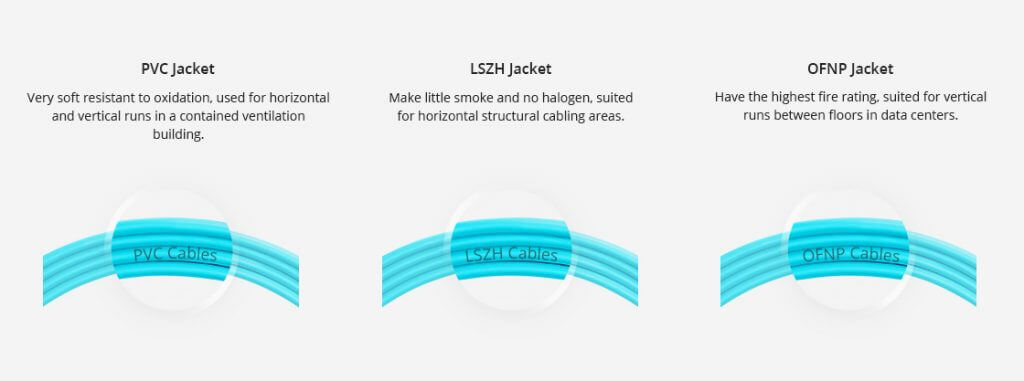
3. Summary
These are the most common fiber jumper types. If you have a clear understanding of the different fiber patch cord types, you can determine which features you need and then make the right choice when choosing. For example, you will know which jacket (PVC/LSZH/OFNP) should be selected, single-mode or multi-mode, which connector polishing type (UPC/APC) should be selected, etc.
Bonelinks is a fiber jumper supplier. Our fiber optic products include LC / SC / ST / FC patch cords, fiber jumpers with different lengths (1m / 5m / 10m / 20m / 30m / 50m), fiber optic splitters, etc. Contact us if you have any needs. We will provide the most suitable fiber jumper solutions.

